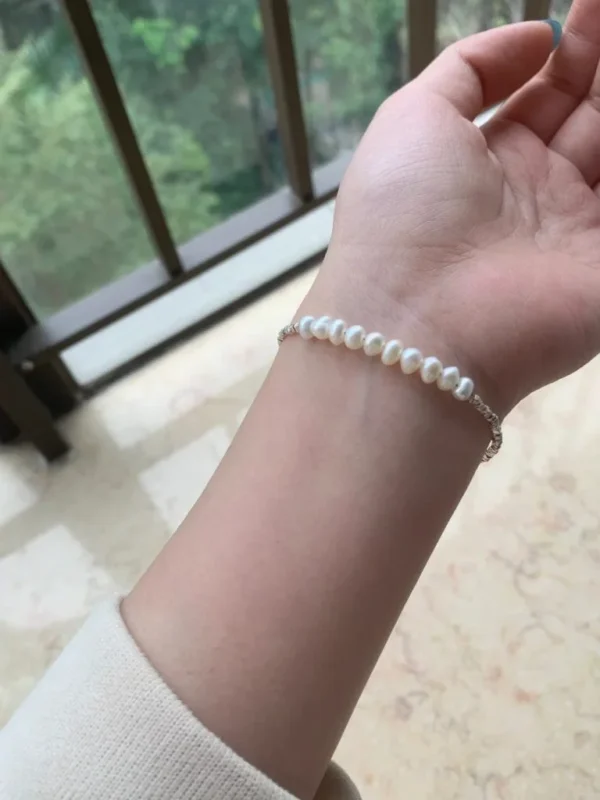Why Do Pearls Lose Their Color Over Time, How to Prevent Pearl Fading

Pearl color fading is a natural process that can affect various types of pearls, from the renowned Tahitian black pearls to Australian White South Sea pearls. While these gems are known for their organic beauty, they can be vulnerable to environmental factors that cause the breakdown of the nacre layers, which results in color loss or diminished luster. In this article, we’ll explore two case studies and provide practical insights on how and why pearls fade after several years of wear.
A Client’s Case: Fading in Australian White South Sea Pearls
One of my clients recently reported noticeable fading in her silver-blue Australian White South Sea pearls after wearing them for five years. Initially, she suspected that the pearls might have undergone some form of artificial dyeing, but after an exchange of detailed questions, we identified several potential causes.
To understand the fading process, I inquired whether the pearls were part of a necklace or a single loose pearl, and whether the fading was uniform or localized. Such specifics help determine whether the color change is due to environmental exposure, improper storage, or a natural degradation of the organic materials within the nacre layers(Pure Pearls)(The South Sea Pearl).
In this particular case, the uniformity of the fading suggested that the breakdown of the conchiolin layer was likely the culprit. The conchiolin, which holds together the aragonite crystals in the pearl’s nacre, can shrink over time, creating vacuum pockets that interfere with the way light reflects off the pearl’s surface.

Another Example: Fading in a Tahitian Baroque Pearl
A similar issue arose with a Tahitian Baroque pearl owned by another client. The pearl, once known for its deep and vibrant hue, had turned a dull brown, with patches of uneven fading. Upon examining the pearl, we found that the color fading was more prominent in certain areas, correlating with a localized degradation of the nacre. The pearl’s once-glossy luster had also diminished, largely due to the breakdown of organic materials in the outer layers of the nacre.
Interestingly, even though the pearl appeared dull to the naked eye, under closer examination, some interference colors such as faint greens and blues were still visible. This demonstrates that while the outer surface may deteriorate, the inner layers of the nacre can retain some of their original colors(LOVELEMENTS Jewelry).
Scientific Explanation: Why Do Pearls Fade?
The color and luster of pearls depend on the quality and compactness of the nacre layers. These layers are composed of aragonite crystals and conchiolin, which are organic materials prone to degradation over time. Environmental factors such as heat, humidity, and contact with chemicals can accelerate this process.
In both the Australian White South Sea pearl and the Tahitian Baroque pearl cases, the fading was primarily caused by the shrinking and aging of the organic conchiolin layer, which created micro-vacuums. These vacuums disrupted light reflection, making the pearls appear dull or discolored.

Can Pearl Fading Be Reversed?
Unfortunately, reversing pearl fading is extremely difficult. The organic components that degrade cannot be easily restored. In rare cases, pearl repair techniques such as injecting synthetic materials into the affected areas have been explored, but these methods are experimental and not widely available. Additionally, there is a risk that these procedures could further damage the pearl’s natural beauty.
However, proper care can help slow down the fading process. It is essential to store pearls in a cool, dry environment, away from direct sunlight, heat, or moisture. Gentle cleaning and careful wearing habits can also protect pearls from premature aging.
Practical Tips for Pearl Care
- Store Properly: Pearls should be stored in a fabric-lined box or a soft pouch, separate from other jewelry items to prevent scratching.
- Avoid Heat and Sunlight: Excessive exposure to sunlight or heat can cause pearls to crack or fade. Keep them in a cool, shaded environment.
- Clean Gently: Use a soft, damp cloth to clean your pearls after each wear, and avoid using harsh chemicals or ultrasonic cleaners.
- Protect from Chemicals: Pearls are sensitive to perfumes, hairsprays, and lotions, which can degrade their luster over time. It’s best to apply such products before putting on your pearls.
Conclusion: Preserve the Beauty of Your Pearls
While pearls are timeless treasures, they require proper care to maintain their beauty. Fading and dulling are natural processes caused by the degradation of the organic materials within the nacre, but with careful storage and maintenance, you can extend the life and luster of your pearls. If you notice any signs of fading, consult a professional for advice on how to best preserve or repair your pearls.
